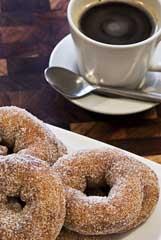Peter Borrows takes us on another excursion into local chemistry
Peter Borrows takes us on another excursion into local chemistry.
In this issue: colloid chemistry at the coffee shop
Tired after your walk, you head for a coffee and doughnut. This introduces us to colloids, tiny particles of one substance (gas, liquid or solid - the disperse phase) suspended (or floating) in another (the continuous phase - gas, liquid or solid). All combinations are possible, except gas in gas, eight in all. Colloids account for a surprisingly high proportion of the substances we come across in everyday life, as a visit to a coffee shop demonstrates.
Coffee, cappuccino and colloids

If you choose a filter coffee, and drink it black, it's difficult to see whether it is a suspension or a solution because of its intense colour. The fact that it has passed through a filter proves little. The particle size in colloids is between 1 nm and 1000 nm so some may pass through the pores of filter paper.
In the interests of science, dilute your coffee down with plenty of water and it will be apparent that this is a genuine solution, it is clear not cloudy. If you have a laser pointer, shine the beam through the diluted solution and look at it at right angles. (CARE: as a result of poor quality control, some laser pointers can damage eyesight if you look directly down the beam.) Is the beam visible? If so, light is being scattered by colloidal particles. This is the Tyndall effect but you don't see it with black coffee. Try the same test on milk - or a latte - again diluted with plenty of water. This time the beam is visible because milk is a liquid in liquid colloid (an emulsion). It is a suspension of fat droplets (the disperse phase) floating in water (the continuous phase).
Perhaps you choose a cappuccino - a latte with foamed milk on top. The foam is another colloid - tiny bubbles of air (the disperse phase), suspended in the continuous phase of milk (which itself is a colloid). In fact even an espresso, if properly made, has a small amount of froth (crema) floating on the intense black solution. The crema is a foam of air suspended in an emulsion composed of vegetable oils and water. Perhaps you decide to have an orange juice, rather than a coffee - that, too, is a colloid. It is a sol, a suspension of solid particles of pulp in an aqueous continuous phase.
Doughnuts ...
What about that doughnut? It's another colloid. Tiny bubbles of air (the disperse phase) suspended in a matrix of dough (the continuous phase). Is it a jam doughnut? Jam is a gel - droplets of water (the disperse phase) held in a solid network (the continuous phase).
Is there 'steam' rushing out of the coffee-making machine? If you can see it, it's not steam, because steam is water in the vapour phase above its boiling point - and invisible. What you can see is another colloid, this time an aerosol, tiny droplets of the disperse phase, water (condensed from genuine steam as it cools), floating in the continuous phase, air. Outside the coffee shop, there might be a cluster of cigarette smokers and their smoke is a solid in gas colloid.
Seven of the eight types of colloid so far - can we find the other one? Are you, or your companion, wearing pearls? Pearls comprise tiny calcium carbonate particles bound together by a protein, conchiolin, a solid in solid colloid. Time for another cappuccino, or should I say, colloid.









No comments yet